The state-of-the-art Beecroft Building opened in September 2018, signalling a pivotal moment for the Department of Physics at the University of Oxford. The 8,950sqm building brings together 200 researchers from theoretical and experimental physics.
The vision for this highly sophisticated facility has become a reality in large part due to the generosity of donors and alumni, who contributed £10 million to the project. The support of Adrian Beecroft, the British venture capitalist and alumnus of the University after whom the building is named, has been particularly significant.
We speak with Professor John Wheater, whose vision for the future of physics at Oxford was key to the development of the Beecroft Building.
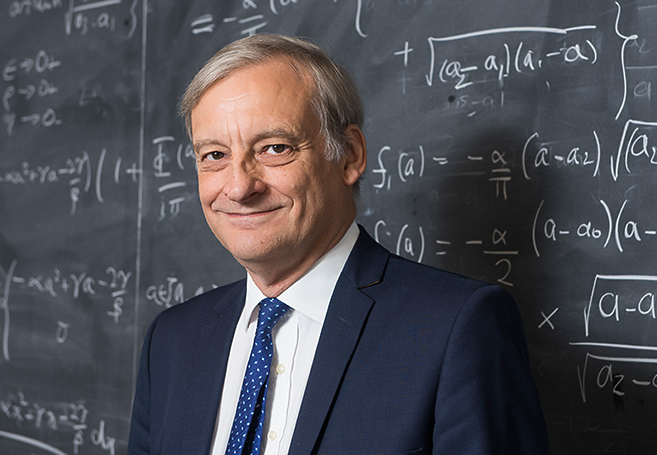
The vision
Prompted by the fact that science was evolving at a pace, but without any new physics research buildings to reflect this for around 50 years, the Department of Physics at Oxford first took steps to address the urgency for contemporary building provision in 2008.
Professor Wheater says: 'The main problems were the lack of very high-quality laboratories and space for people to work in a modern way. This building is designed to address both of those issues.'
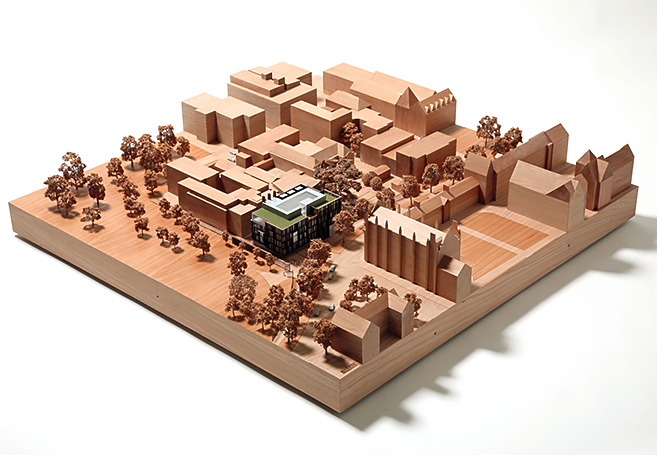
The design
The Beecroft Building is a ten-storey building, but only five storeys are above ground level. Within the basement – which, at 16 metres, is the deepest in Oxford – there are high specification laboratories suitable for carrying out extremely environmentally-sensitive research.
While the laboratories are located underground, the theoreticians' offices and discussion spaces for everyone, are above ground level. The whole building is deliberately designed to encourage and enable scientists to interact with each other in a pleasant, collaborative environment.
As well as having break-out areas between the floors of each upper level, the atrium offers space to hold exhibitions and events, and giant bleacher-style 'steps' (pictured) double as an informal auditorium on the ground floor.
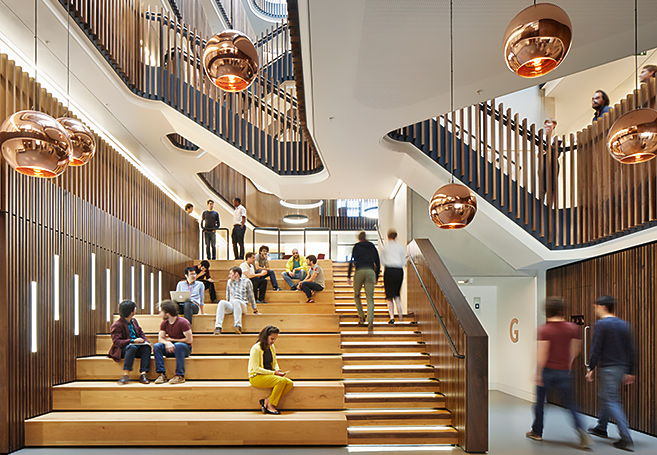
Collaborative space
Of the collaborative working spaces, Professor Wheater says: 'One of the basic criteria for this very interactive building was for researchers to be able to see when there were groups of people sitting around talking about science.
'Theorists in particular, but also experimental physicists, write on blackboards, so you can see roughly what they're doing. The whole idea was that you could see these conversations going on and you could join them. The aim is to trigger new collaborations, new groups of people working together, and the spread of ideas and techniques across the community.'
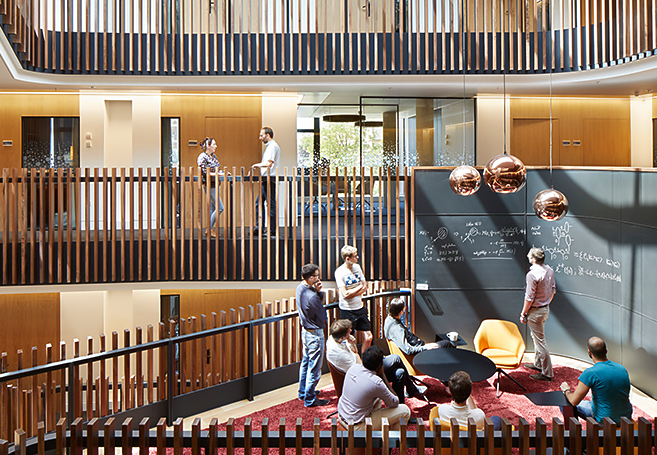
The laboratories
In the laboratories, it is possible to maintain very rigorous conditions – such as temperature control to within a tenth of a degree and vibration isolation – that enable the extraordinary exactitude required for atomic-level experiments and investigating the most basic properties of nature.
Professor Wheater says: 'We think we know what the laws of nature are, but we also know that they're not completely consistent. One way of attacking this is to conduct very high precision measurements of systems that you think you understand extremely well and look for very small discrepancies between your experiment and your theory.
'There are very few institutions around the world which have laboratories of this standard where you can do work of such delicacy and accuracy.'
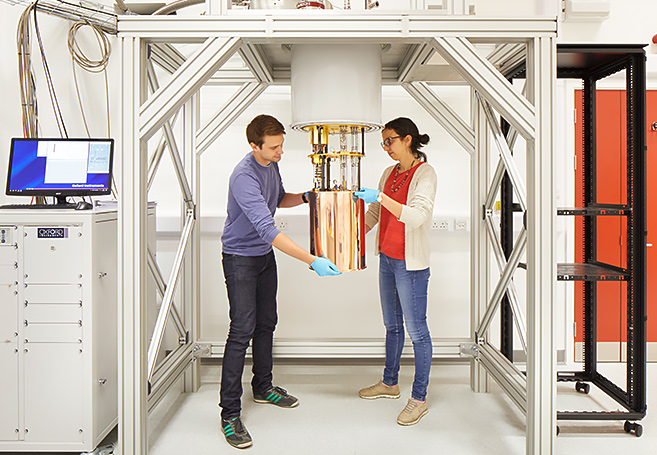
The science
The vision for the department is to conduct science in areas where physicists can have significant insight. The building now houses the Wolfson Centre for Quantum Science and Technology, thanks to a Wolfson Foundation grant of £1.9 million towards the project. The Engineering and Physical Sciences Research Council (EPSRC) also granted £3.2 million to Oxford in support of the Beecroft Building in the knowledge that the new high specification laboratories would enable research beyond the capabilities of most other facilities.
'The scientific problems that we are interested in are the really tough ones, at the cutting edge of science globally,' explains Professor Wheater, 'so we are aiming to be one of the world's leading science departments.
'Collaboration between the experimental and the theoretical is crucial to success. You refine your understanding of nature through a cycle of theoretical modelling, theoretical understanding of a system, and experimental probing to develop a theoretical model which really does describe the way nature or systems behave. It's a very symbiotic thing. You need both working closely together to understand nature.'
There are already plans for the department to build a demonstrator quantum computer and to visualise quantum systems at the level of individual atoms. The new building will house two varieties of microscope under optimal conditions. One is the atomic force microscope, or AFM, which detects the mechanical contact force between atoms. Previously, the most delicate experiments using an AFM could only be performed at night in Oxford to avoid vibrational interference. The second is a scanning tunnelling microscope, or STM, which uses the quantum tunnelling current that flows across the tiny gap between probe and surface. It would not have been possible to use an STM previously due to an inability to totally eliminate low levels of extraneous vibration affecting the outcome of an experiment.
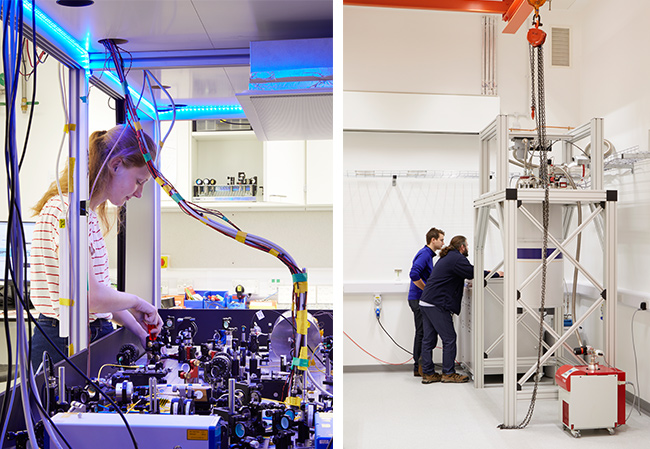
Open for business
The Beecroft Building celebrated its official opening on 17 September 2018. Has the reality met with Professor Wheater's expectations?
'When we first moved in, the collaboration areas in the middle were instantly being used by people,' he says, 'but the particularly striking thing was that they were all under 30 – it took us older types a little longer to catch on.
'Now, you will see groups of people of all generations in the department sitting in these open collaboration areas discussing science. This is a good start, but it will be very interesting in five years to see what science has come out of having this building available, which may not have happened otherwise.'
Professor Wheater reports that the Beecroft Building is already attracting the best scientists from around the world, demonstrating a confidence that this will be the birthplace of significant scientific breakthroughs of the future. For now, he is content to marvel at more modest breakthroughs: 'One of the interesting things that's happened in this building since we moved is that people have said to me "I now regularly see person X – I never saw person X before." The way the building is designed, you have to walk past and say hello.'
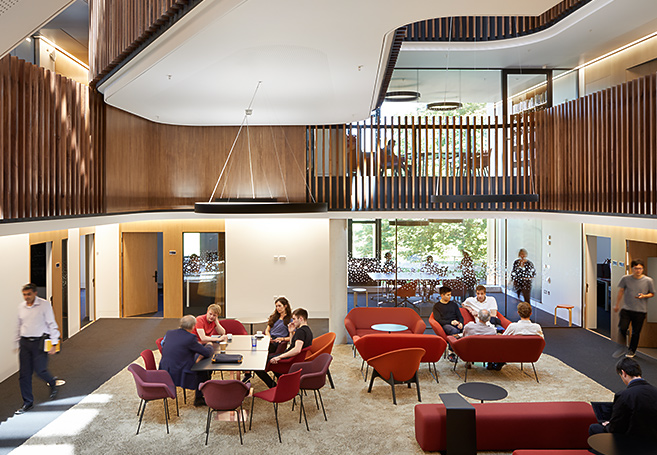
The Beecroft Building was designed by architects Hawkins\Brown.